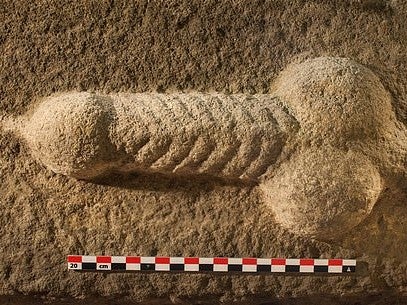Cock of the north: Roman stone-carved penis uncovered during Yorkshire archaeological dig
Eleven inch phallus is one of 62,000 ancient artifacts found in major excavation works

Your support helps us to tell the story
From reproductive rights to climate change to Big Tech, The Independent is on the ground when the story is developing. Whether it's investigating the financials of Elon Musk's pro-Trump PAC or producing our latest documentary, 'The A Word', which shines a light on the American women fighting for reproductive rights, we know how important it is to parse out the facts from the messaging.
At such a critical moment in US history, we need reporters on the ground. Your donation allows us to keep sending journalists to speak to both sides of the story.
The Independent is trusted by Americans across the entire political spectrum. And unlike many other quality news outlets, we choose not to lock Americans out of our reporting and analysis with paywalls. We believe quality journalism should be available to everyone, paid for by those who can afford it.
Your support makes all the difference.A Roman stone-carved penis is one of thousands of artefacts discovered during half a decade of excavation work around the town of Catterick, it has been revealed.
The 11in phallus – complete with line of ejaculate – is believed to date back to the early years of the ancient empire’s occupation of Britain, which began in the first century AD.
It is among more than 62,000 historical objects unearthed during five years of archaeological digs undertaken as part of work to upgrade the A1 around the North Yorkshire town – which was founded by the Romans.
Other treasures include a 2,000-year-old pistachio nut – the oldest ever found in Britain – as well as pottery, incense burners, brooches and works of art which were probably brought from the Mediterranean.
The phallus itself was first dug up in 2014 – and the excavation work completed in 2018 – but a full analysis of all objects has just been completed by the Northern Archaeological Associates.
All the items, which also includes 2.8 tonnes of animal bone and 2.5 tonnes of pottery, will now be held at the Yorkshire Museum in York.
Taken together, experts say the collection offers one of the most significant insights into life in a Roman fort town ever unearthed.
Dr Jonathan Shipley, principal heritage consultant with AECOM – the infrastructure giant which carried out the road improvements – said it would “hugely increase our understanding of the development of the site”.
And Helen Maclean, also of AECOM, added: "This brings to completion 17 years of integrated archaeological and engineering work on the A1.
"There have been some fantastic discoveries during the archaeological work, which have greatly enhanced our archaeological knowledge."
Digs along the A1 are considered to hold particular potential in terms of historic finds because the modern road partly follows the the old Roman route between York and Hadrian's Wall.

Join our commenting forum
Join thought-provoking conversations, follow other Independent readers and see their replies
Comments